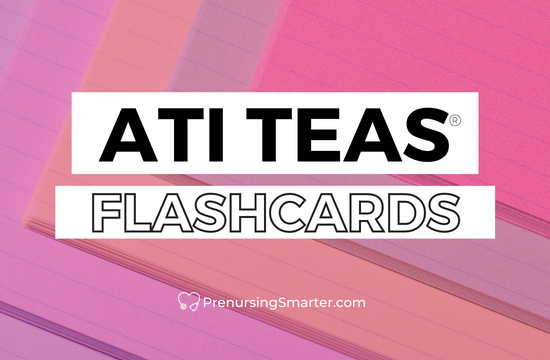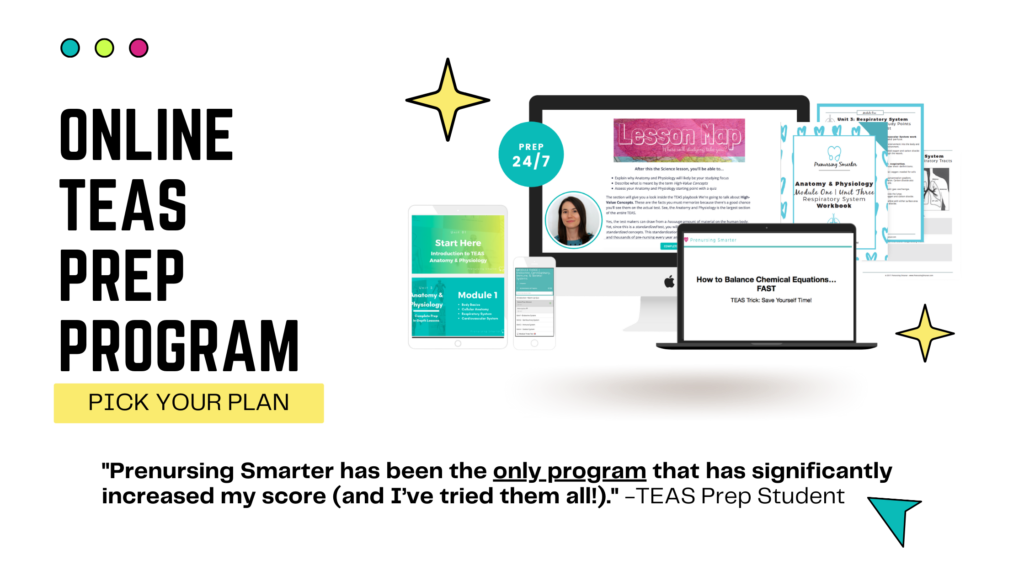TEAS test flashcards are a great way to prep. Here are some TEAS exam flashcards to help you. We’ll start with TEAS science flashcards because they are the most popular, but keep reading for free ATI TEAS flashcards for every section.
TEAS Science flashcards
ATI TEAS Science Flashcards: Anatomy and Physiology
Here’s how to structure your TEAS 7 science flashcards for anatomy and physiology. For each body system, know the…
- Anatomical structures–the body organs, tissues, and/or cells that are unique to each system
- Physiological functions–the processes and actions that occur at the different structures
- Interactions with other body systems
- Communications with the body
- Pathology common in the system
TEAS Science Flashcards: Biology
More tips for what to include in TEAS exam flashcards:
- Comparing and contrasting DNA, genes, chromosomes
- Basic structure of DNA and RNA
- Expected ratios of Mendelian genetics
- Types of non-Mendelian genetics
- Qualities of macromolecules: carbohydrate, lipid, protein, and nucleic acid
Need more? Check out my TEAS science practice questions or sign up for my free preview and get 18 pages of free printable TEAS exam flashcards.
TEAS Test Science Flashcards: Chemistry
Here are some more topics to add to your TEAS exam science flashcards:
- The organization of the periodic table
- Chemical bonding (ionic vs. covalent)
- The properties of water
- The properties of acids and bases
Want more TEAS practice? Grab my TEAS practice question bank for more.
Here’s what Prenursing Smarter student Alex had to say about the program:
“I haven’t taken Anatomy or Physio yet, and Math/Bio/Chem haven’t been used in like 10 years lol. But I just got home from my first test attempt and managed an 82.3%. I’ll be submitting my application to a Nursing program this fall The structure and information provided in your course was honestly so helpful.”
TEAS 7 flashcards: Reading
Curious what is in this section? Check out my TEAS Reading study guide.
Free TEAS flashcards: Math
TEAS 7 flashcards: English
Free printable TEAS test flashcards
TEAS test flashcards inside my free preview of Prenursing Smarter. You can download 18 pages of free printable PDF TEAS flashcards for your review!
ATI TEAS flashcards Quizlet
Prenursing Smarter has tons of ATI TEAS flashcard Quizlet sets. Find my TEAS flashcards Quizlet sets under the username PrenursingSmarterPro. Just search for my TEAS 7 Quizlet folder. You can also print the TEAS flashcard Quizlet sets within the Quizlet app.
ATI TEAS flashcard study system
In my online TEAS prep course, you get digital and printable PDF TEAS flashcards for download. Here are some tips on how to use your ATI TEAS flashcard study system.
Tip #1: Focus your TEAS flashcards on terms, formulas, and sequences
TEAS Flashcards work great for specific, quick facts. Examples of how to use TEAS test flashcards:
- Definitions of literature terms, like passage types or source types
- Matching organs and hormones
- Math formulas for calculating the area of different shapes or the formulas for percent increase and decrease
- Grammar and punctuation rules for compound, complex, and simple sentence types
ATI TEAS flashcards are great for when you need to memorize a particular definition, match terms and/or functions (like an organ and its functions or hormones), or memorize specific rules or formulas.
You’ll need to be able to call upon these rules quickly on test day.
Tip #2: Sequences are important for the TEAS 7
Use TEAS exam flashcards to help you with sequence questions. The ATI TEAS 7 has a variety of question types, including ordering and fill-in-the-bank questions. You’ll likely be tested on sequences for these questions.
How to use TEAS test flashcards for sequences:
- Following path of blood through the heart and body
- The steps of digestion and absorption in the gastrointestinal system
- The order of filtration through the kidneys
For example, when blood flows through the heart, it travels through 4 chambers, 4 valves, and some important arteries and veins.
For the ATI TEAS, you’ll need to be able to quickly recall their order so that you can answer whatever question comes your way.
A great way to learn this is to write out the order, with each step of blood flow getting its own card. Give them a shuffle. How quickly can you put them in the correct order?
Here are sequence TEAS practice questions from my online TEAS prep class:
How to use Free TEAS test flashcards
Narrow your topics. Don’t make flashcards for everything under the sun. Instead, focus on definitions, formulas, matching concepts, or ordering concepts.
Keep flashcards on sequences and ordering separate. Keep these TEAS test flashcards separate for terms/formulas. You’ll want to shuffle and match. Make a game out of how quickly you can time yourself.
Do your TEAS exam flashcards for 10 minutes a day. Focus on review and recall. Repetition over time is the key.
TEAS exam flashcards work best when you are reviewing, not learning. Make sure you understand the underlying concept before working on memorization.
Here’s what Prenursing Smarter student said about using Prenursing Smarter for her TEAS 7 review:
“Oh my gosh thank you SO MUCH for this program! I’ve taken the TEAS three times before finding your program. I was using all the other study material for the TEAS that you can think of and nothing was helping me pass the reading section. My school goes based off each sections %, not overall %. I needed an 80% in reading and just couldn’t seem to get there. I used your program for less than a week and was able to finally score high enough! All thanks to your tips and strategies I went from a 76% to a 84.6%!! I told everyone I know about your program! Thank you!!!”

Kate is a CRLA certified tutor and test prep expert. She founded Prenursing Smarter in 2017. Kate lives in sunny Southern California and is an enrolled member of the Cheyenne River Sioux Tribe (Mnikȟówožu Lakȟóta). Prenursing Smarter is an inclusive business and actively seeks opportunities to collaborate with and support diverse voices.


